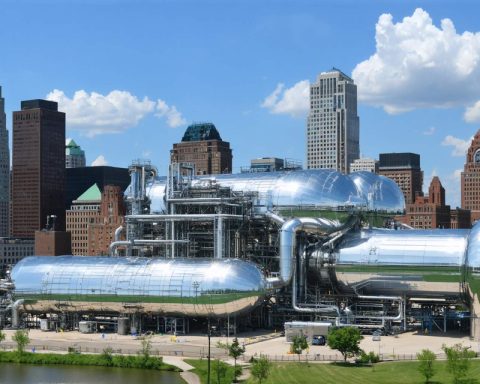- Clean hydrogen projects are gaining significant attention, with major companies like bp and Shell leading initiatives aimed at transforming the energy sector.
- There has been a 90% increase in final investment decisions since October 2023, indicating strong interest and potential in hydrogen energy.
- Currently, 434 projects have reached crucial stages, highlighting a surge in hydrogen-focused endeavors.
- Key challenges include the need for consistent financial support, effective risk management, and alignment with evolving market trends and policies.
- Building a sustainable hydrogen economy requires strategic innovation and adaptability to overcome technical and economic barriers.
- As global demand for clean energy grows, hydrogen is positioned as a promising solution, though its viability is still emerging.
- Successful navigation through these challenges could lead to significant environmental and economic benefits from a hydrogen-powered energy future.
A wave of anticipation sweeps through the energy sector as clean hydrogen projects garner renewed attention. Leading the charge, industry titans like bp and Shell have committed to transformative endeavors aimed at revolutionizing the future of energy. However, despite an impressive 90% spike in final investment decisions (FIDs) since October 2023, the dream of hydrogen-fueled promises remains just out of reach.
The landscape brims with potential as 434 projects cross critical milestones. Yet, beneath this optimistic surge lies a complex web of challenges. The success of these initiatives hinges delicately on a trio of essentials: unwavering financial backing, astute risk management, and a harmonious alignment with ever-shifting market trends and policies.
Sculpting a robust and sustainable hydrogen economy requires more than just financial enthusiasm or strategic ambition. It demands a finely tuned symphony of strategic innovation and adaptive foresight. As global energy demand collides with the pressing need for clean alternatives, clean hydrogen remains tantalizingly poised at the cusp of greatness yet burdened by its nascent bankability.
Observers watch keenly, knowing the stakes. The road ahead requires not just investment but a galvanized commitment to overcoming technical and economic barriers. For those who grasp the reins effectively, hydrogen offers a promise of greener futures and sustainable prosperity.
The takeaway is clear: while the pathway to a hydrogen-powered world is fraught with complexities, the rewards await those bold enough to navigate these tides. The world watches with bated breath — the era of clean hydrogen may be closer than it seems.
The Hidden Powerhouses: Discover How Clean Hydrogen Could Transform Our World
How-To Steps & Life Hacks
Transitioning to clean hydrogen involves several strategic steps:
1. Infrastructure Development: Invest in building electrolysis plants where water splits to produce hydrogen. Countries like Germany and Japan are forerunners in this technology.
2. Partnerships and Collaborations: Team up with technology providers, energy companies, and governments. BP and Shell are already trailblazers in creating consortia to pool resources.
3. Policy and Regulatory Alignment: Stay informed about subsidies, tax incentives, and policy frameworks that support hydrogen initiatives. The EU’s Hydrogen Strategy is a vital reference point.
4. Public Awareness and Education: Build campaigns to educate citizens on hydrogen’s benefits compared to fossil fuels.
Real-World Use Cases
– Transportation: Hydrogen fuel cells power buses and trucks, significantly reducing emissions. Cities like Los Angeles have integrated hydrogen-powered public buses.
– Industrial Applications: Hydrogen can decarbonize sectors like steel and cement, where alternatives to fossil fuels are limited.
– Energy Storage: Hydrogen acts as a storage medium, offering solutions for renewable energy’s intermittent nature.
Market Forecasts & Industry Trends
The global hydrogen market is expected to reach USD 201 billion by 2025, growing at a CAGR of 6% from 2020 to 2025 (GlobeNewswire). A significant push comes from government policies promoting zero emissions.
Reviews & Comparisons
Green hydrogen—that produced via renewable energy—is preferred over grey or blue hydrogen, which involves non-renewable energy sources and carbon capture technologies, respectively. Although more costly, green hydrogen’s environmental benefits make it highly favorable.
Controversies & Limitations
One of the controversies surrounding hydrogen energy includes the “energy loss” during the conversion process from electricity to hydrogen. Critics argue this inefficiency makes it less viable than other renewable options like direct solar or wind power.
Features, Specs & Pricing
– Production Techniques: Electrolysis and steam methane reforming (with carbon capture) are the primary methods of hydrogen production.
– Costs: As of 2023, producing green hydrogen costs between $3 to $6 per kg. Prices are dropping due to advancements in technology and economy scales.
Security & Sustainability
Hydrogen is non-toxic and lighter than air, which prevents pooling and cutoff in confined spaces, but it requires secure storage due to its high flammability. Innovations in storage technology are ongoing to increase safety.
Insights & Predictions
Industry experts predict that hydrogen could meet up to 24% of the world’s energy needs by 2050, helping to reduce carbon emissions by up to 20% annually.
Tutorials & Compatibility
– Electrolysis Efficiency: Use water electrolysis tutorials to improve production methods. Maintenance involves regular system monitoring for energy influx adjustments.
– Fuel Cell Integration: Learn the compatibility of hydrogen fuel cells with varying vehicle types.
Pros & Cons Overview
Pros:
– Clean energy source with only water vapor as a byproduct.
– Versatile applications across sectors.
– Potential for global energy market disruption.
Cons:
– High initial production costs.
– Infrastructure development is necessary.
– Energy conversion efficiency is currently a challenge.
Actionable Recommendations
1. Invest in Research and Development: Prioritize R&D to improve hydrogen production efficiency and reduce costs.
2. Commit to Education: Educate stakeholders on benefits and operational safety measures.
3. Explore Government Incentives: Keep abreast of financial incentives that support clean hydrogen projects.
4. Engage in Partnerships: Enter collaborative ventures for technology sharing and infrastructure investment.
By following these actionable steps, the transition to a hydrogen-powered future becomes more feasible and aligned with sustainability goals.














